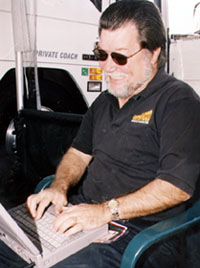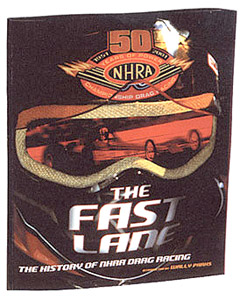 There's a statue of Wally Parks outside the NHRA Motorsports Museum in Southern California. It's an imposing piece of bronze art that stands vigil at the entrance to what has become the legacy of the 88-year-old founder of the world's largest automotive sanctioning body. It is how I will choose to remember Wally once he's gone -- as larger than life, an icon; not as the vindictive and petty individual who took the editor's pen to an aesthetically spectacular book produced to celebrate the organization's 50th anniversary.  "THE FAST LANE: The History of NHRA Drag Racing" is depicted in NHRA's press releases as a "230-page retrospect (that) features full-color photographs with extraordinary insights into the NHRA's beginnings, fiery personalities, technological achievements and passionate fans." "THE FAST LANE: The History of NHRA Drag Racing" is depicted in NHRA's press releases as a "230-page retrospect (that) features full-color photographs with extraordinary insights into the NHRA's beginnings, fiery personalities, technological achievements and passionate fans."
If only it were so. In fact, the fiery personalities, at least the ones I recall, are largely absent from the pages of what could have been the definitive history of a remarkable sport. Instead, it is revisionist history. For instance, the nitro ban of the 1960s, which gave rise to Jim Tice and the rival AHRA, never happened. According to Wally, there was no nitro ban. There simply was a period in NHRA's development during which the sanctioning body chose not to contest a nitro championship. Case closed. With that as a foundation, what in the world could have been the criteria for inclusion in a book that supposedly chronicles the sport's evolution? For a definitive view, I would suggest you archive last month's commentary by Jon Asher on Speedvision.com. While all of Asher's comments are valid and while it would serve no purpose to belabor them any further, I couldn't help but chuckle at his suggestion of an alternate title: "The Fast Lane: NHRA Drag Racing" followed by an editor's note explaining that "this book contains only images and copy about racers deemed worthy of inclusion by the NHRA." However, don't think for a minute, even a second, that the snub of Don Garlits -- which is the one that leaps out at anyone with the slightest knowledge of the sport -- was orchestrated by Tom Compton and the new NHRA regime which so often has been taken to task for its lack of historic perspective. No, this was a hatchet job authored by Parks himself with the apparent assistance and support of board member Dick Wells. What they have done in largely excluding personalities like Garlits is the high speed equivalent of ethnic cleansing, a despicable term attached to the slaughter of thousands of Europeans who did not share the view of the party in power. It's not how Wally Parks should be remembered. Wally was my mentor at NHRA during the years in which I was employed as the company's Publicity Director. When Garlits was sniping at the organization from one side and IHRA founder Larrry Carrier was sniping from the other, Wally steadfastly refused to get involved in the mud-slinging, no matter how hurtful and false the accusations might have been. Having grown up in the NHRA family under the tutelage of Division 4 Director Dale Ham, who introduced me to the sport and stoked my passion for it, it was I who wanted to respond individually to each and every attack, especially those which targeted Wally personally. The Big Indian never allowed that. He opted to turn the other cheek. He told me that was not the NHRA way. He told me that as the keeper of the drag racing flame, we had to be better than that. He told me that NHRA had to keep its eye on the bigger picture and, as a result, that we simply would not, he emphasized the term "would not," involve ourselves in petty feuds with those he perceived as petty individuals. When Wally was considering writing a memoir, it was suggested that in order to expand the consumer market for such an offering he should be candid about his relationship with those who had tried, over the years, to undermine his efforts -- specifically Garlits, Carrier and Tice. He never was comfortable with that strategy, which makes his stance with regard to the 50th anniversary book all that more bizarre. Garlits long ago buried the hatchet. In fact, last March, at a time when Wally apparently already was X-ing him out of the book, the greatest drag racer of all time was presenting Wally and his wife, Barbara, "The Founders Award," the most prestigious honor bestowed by his International Drag Racing Hall of Fame. And Garlits didn't mail it in. He made a very magnanimous, gracious speech, one which was both necessary and appropriate. Wally's response was neither necessary nor appropriate and, because of that, I am very sad. I'm not sad for Don Garlits, because his legacy is assured. I'm not sad for drag racing because, despite its problems, it will persevere. I am sad for Wally Parks, a wonderful, caring individual who apparently still is not aware of the scope of his impact not only on drag racing, but on motor sports as a whole. If he were, he would have no need to focus on slights, real or perceived, which occurred a millennium ago. If he had the feeling of accomplishment that at this point should be is, he would have had no problem acknowledging the role that Garlits and others played in a drag racing drama that he wrote, produced and directed to the longest off-Broadway run in history. I hope that, like me, people will remember all the good, wonderful, remarkable things Wally Parks did in making the sport what it is today -- and that they will forget that one day he tried to rewrite history. "THE FAST LANE: The History of NHRA Drag Racing" is available from Tehabi Books (toll free) 888-577-4759. Dave Densmore, a paid columnist for DRO, also works for John Force. Photo of Densmore by Jeff Burk
|